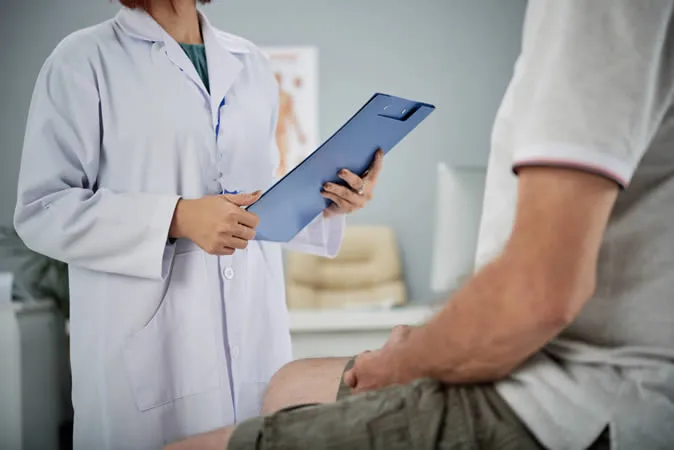What is Dermatomyositis?
Dermatomyositis is a rare inflammatory disease that affects both the skin and the muscles. It causes a distinctive skin rash, usually on the face, eyelids, chest, and joints, and muscle weakness, especially in the neck, arms, and hips. The cause of dermatomyositis is unknown, but it may be related to an autoimmune disorder or a viral infection. Dermatomyositis can also be associated with some types of cancer.

What are the signs and symptoms of Dermatomyositis?
Some of the signs and symptoms of dermatomyositis are:
- A violet-colored or dusky red rash that develops on your face, eyelids, chest, back, knuckles, elbows, knees, and joints. The rash can be itchy and painful.
- Muscle weakness that affects the muscles closest to the trunk, such as those in your hips, thighs, shoulders, upper arms, and neck. The weakness is progressive and affects both sides of your body.
- Difficulty swallowing, which can cause weight loss, malnutrition, and aspiration pneumonia.
- Breathing problems, which can result from inflammation of the chest muscles or lung damage.
- Calcium deposits under the skin, which can cause pain and infection.
- Raynaud’s phenomenon, which causes your fingers, toes, cheeks, nose, and ears to turn pale when exposed to cold temperatures
What are the causes of Dermatomyositis?
The causes of dermatomyositis are not fully understood, but they may involve a combination of genetic and environmental factors. Some possible causes are:
- Autoimmune disorders: These are conditions where your immune system mistakenly attacks your own healthy cells. Dermatomyositis may be similar to some autoimmune diseases, such as lupus, rheumatoid arthritis, and scleroderma.
- Viral infections: Some viruses may trigger or worsen dermatomyositis, such as coxsackievirus, human immunodeficiency virus (HIV), and human T-cell leukemia virus type 1 (HTLV-1).
- Sun exposure: Ultraviolet (UV) rays from the sun may damage your skin and cause inflammation. This may increase your risk of developing dermatomyositis or make your symptoms worse.
- Certain medications: Some drugs may cause a reaction that resembles dermatomyositis, such as hydroxyurea, penicillamine, and statins. This is called drug-induced dermatomyositis and usually improves after stopping the medication.
- Smoking: Smoking may increase the inflammation in your body and affect your blood vessels. This may contribute to the development or progression of dermatomyositis.
What treatments are available at the dermatologist for Dermatomyositis?
Some of the treatments that are available at the dermatologist for dermatomyositis are:
- Antimalarial medications: These are drugs that can help reduce the skin rash and inflammation caused by dermatomyositis
- Sunscreens: These are products that can protect your skin from sun exposure, which can worsen the rash and inflammation of dermatomyositis.
- Skin or muscle biopsy: These are procedures that can help confirm the diagnosis of dermatomyositis and rule out other skin or muscle conditions. A dermatologist can perform a skin biopsy by taking a small sample of skin from the affected area and examining it under a microscope
- Arthroscopy: This is a surgical procedure that can help remove painful calcium deposits that may form under the skin in some cases of dermatomyositis.

How to Recognize Dermatomyositis
To recognize dermatomyositis, you need to pay attention to the following signs and symptoms:
- Skin changes
- Muscle weaknes
- Difficulty swallowing
- Breathing problems
- Calcium deposits
- Raynaud’s phenomenon
FAQ About Dermatomyositis
What are the potential complications or risks of dermatomyositis?
Dermatomyositis is a rare inflammatory disease that affects both the skin and the muscles. It can cause various complications or risks, such as Difficulty swallowing, Breathing problems, Calcium deposits, Raynaud’s phenomenon, Other connective tissue diseases, Cardiovascular disease & Cancer
What are some of the characteristic skin manifestations of dermatomyositis?
Some of the characteristic skin manifestations of dermatomyositis are Heliotrope rash, Gottron’s papules, Shawl sign, V sign, Holster sign, Mechanic’s hands, Nail fold changes & Calcinosis cutis
What are some of the rare or unusual forms of dermatomyositis?
Some of the rare or unusual forms of dermatomyositis are Dermatomyositis sine myositis, Clinically amyopathic dermatomyositis, Juvenile dermatomyositis, Paraneoplastic dermatomyositis & Overlap syndromes
Is there a dermatologist near me in Oceanside that offers treatment for dermatomyositis?
Yes. At our Oceanside dermatology office we offer treatment for dermatologist to patients from Oceanside and the surrounding area. Contact our office today to schedule an appointment.

